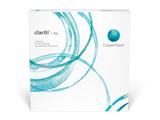
Dr. Desmond Fonn is a well-recognized and respected figure within the contact lens industry. The University of Waterloo bestowed the honor of “Distinguished Professor Emeritus” to Dr. Fonn in June 2012 in recognition of his research and work to the university and academic community.
At CooperVision, we are thrilled to share an article that Dr. Fonn has provided to us exclusively. The subject is on astigmatism and toric soft contacts. (You can read Dr. Fonn’s article here on our blog that’s geared to eye care professionals.)
Since Dr. Fonn’s article is written for eye doctors, we wanted to provide you with its findings in a manner that the rest of us would find more digestible to the layperson. After all, the information contained within it is extremely interesting.
Essentially, Dr. Fonn says that if you have refractive astigmatism, and you would rather wear contact lenses instead of glasses, eye doctors should fit you with toric soft lenses. (By “fit” here, we mean the process of an eye doctor examining your eyes and finding the right lenses for your prescription.)
So let’s break this statement down:
“Refractive astigmatism” refers to the refractive visual blurriness you get from a cornea or lens that’s stretched into an irregular shape (think: more like a football instead of a basketball).
This causes a refractive error, or a distorting of light as it enters your eyes. Because of this, nearly everything you see—near or far—may appear slightly blurry depending upon how much distortion you’re experiencing.
Dr. Fonn goes on to say that soft lenses provide superior comfort, which is naturally what everyone wants. This makes sense. So where is the problem?
Toric contact lenses must be “fitted,” in industry parlance, so that they are oriented the right way to correct your individual vision needs. This is often done by providing “thin thick” zones in the lens, so that the bottom is heavier than the top. This helps gravity pull the thicker part of the lens down for the correct orientation.
In his summary, Dr. Fonn says, “As the average thickness of toric lenses is influenced by the by prism ballast or periballast and therefore increased thickness in parts of the lens, the oxygen transmissibility may be compromised and this will almost always be negated by the use of silicone hydrogel materials.”
Here, he’s referencing the lens stabilizing we just covered. This increased thickness in the lens could affect the ease at which oxygen can pass through the lenses. This is important because your corneas get their oxygen straight from the air around us. Unlike our other body tissues, the cornea contains no blood vessels to deliver needed oxygen.
However, silicone hydrogel lenses can help provide excellent oxygen transmissibility. (This is measured in their “Dk” value, often written as “Dk/t,” if your eye doctor should mention it to you.) Since silicone hydrogel lenses tend to offer a higher rate of oxygen transmission (there’s our “Dk/t” number) than standard hydrogel contacts, this would negate the increased thickness at the bottom of the soft toric lenses.
Simply put, you would have your “contact lens comfort” cake and eat it, too—and that’s always a good thing.
We invite you to read the entire article by Dr. Fonn here. If you have any questions or would like to comment, please feel free to do so below!
Nothing in this article is to be construed as medical advice, nor is it intended to replace the recommendations of a medical professional. For specific questions, please see your eye care practitioner.





